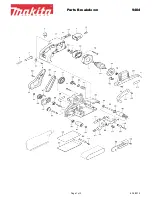
ENGLISH
32
strings. Loose and spinning attachment
strings can entangle your fingers or
snag on the workpiece.
Polishing pads with a diameter of 150, 180 or
230 mm (6", 7" or 9") may be used with the
DWP849X.
NOTE:
The DWP849X may use either type of
polishing pad assembly described below.
TO ATTACH POLISHING PAD WITH RUBBER BACKING PAD
(FIG. 3A)
1. Engage the hexagonal hole in the backing pad
(o). Holding the clamp washer (n) and backing
pad firmly together, place the assembly on the
tool spindle (h).
2. Hold the spindle lock button (d) while turning the
backing pad and clamp washer clockwise to
thread them completely on the spindle. Tighten
firmly by hand.
3. Fix the polishing pad (m) onto the backing pad.
TO ATTACH POLISHING PAD WITH HOOK AND LOOP
BACKING PAD (FIG. 3B)
1. Attach hook and loop foam or wool pad (p) to
hook and loop backing pad (q), being careful to
center the backing pad with the foam or wool
pad.
2. Screw backing pad (q) onto spindle (h), while
depressing spindle lock button (d).
TO REMOVE PADS
Turn the pads by hand in the opposite direction
from normal rotation to allow lock button to engage
spindle, then unscrew pads in normal direction for
right-hand thread.
Prior to Operation
1.
Be sure the polishing pad is mounted correctly.
2. Make sure the pad rotates in the direction of the
arrows on the accessory and the tool.
3.
Make sure any dirt is washed off the workpiece
surface.
OPERATION
Instructions for Use
WARNING:
Always observe the safety
instructions and applicable regulations.
WARNING: To reduce the risk
of serious personal injury, turn
tool off and disconnect tool from
power source before making any
adjustments or removing/installing
attachments or accessories. Before
reconnecting the tool, depress and
release the trigger switch to ensure
that the tool is off.
WARNING:
•
Apply only a gentle pressure to the
tool. Do not exert side pressure on the
backing pad.
•
Avoid overloading. Should the tool
become hot, let it run a few minutes
under no load condition.
Proper Hand Position (fi g. 4)
WARNING:
To reduce the risk of
serious personal injury,
ALWAYS
use
proper hand position as shown.
WARNING:
To reduce the risk of
serious personal injury,
ALWAYS
hold
securely in anticipation of a sudden
reaction.
Proper hand position requires one hand on the side
handle (e) or the bale handle (g), with the other hand
on the main handle (r).
Variable Speed Trigger Switch
(fi g. 1)
The variable speed trigger switch permits speed
control from 0 to 3500 RPM.
To turn the tool on, squeeze the trigger switch (b).
The farther you depress the trigger, the faster it will
operate. Releasing the trigger turns the tool off.
Use lower speeds for applying liquid waxes and
polishes and higher speeds for removing dried liquid.
TRIGGER LOCKING BUTTON
The tool can be locked on for continuous use by
squeezing the trigger switch (b) fully and depressing
the lock button (f) shown in figure 1. Hold the lock
button in as you gently release the trigger switch.
To turn the tool off from a locked-on position,
squeeze and release the trigger switch once. Do
not unplug the tool with the switch in the locked-on
condition. Make sure the tool is not locked on when
plugging in.
NOTE:
The trigger switch can only be locked
on with the tool running at the maximum RPM
designated by the speed control wheel (a).
NO-VOLT RELEASE
The variable speed trigger switch (b) has a no-volt
release function. In the event of a power outage
or other unexpected shut down, the trigger switch
needs to be cycled (depress the trigger switch,
release, then depress again) to restart the tool.
Summary of Contents for DWP849X
Page 1: ...DWP849X ...
Page 3: ...1 Figure 1 b g d h c f a j i d a k e ...
Page 4: ...2 Figure 2 Figure 3A j l h d q p m n o h d Figure 3B d ...
Page 5: ...3 Figure 4 r e g ...
Page 147: ...145 ...
















































